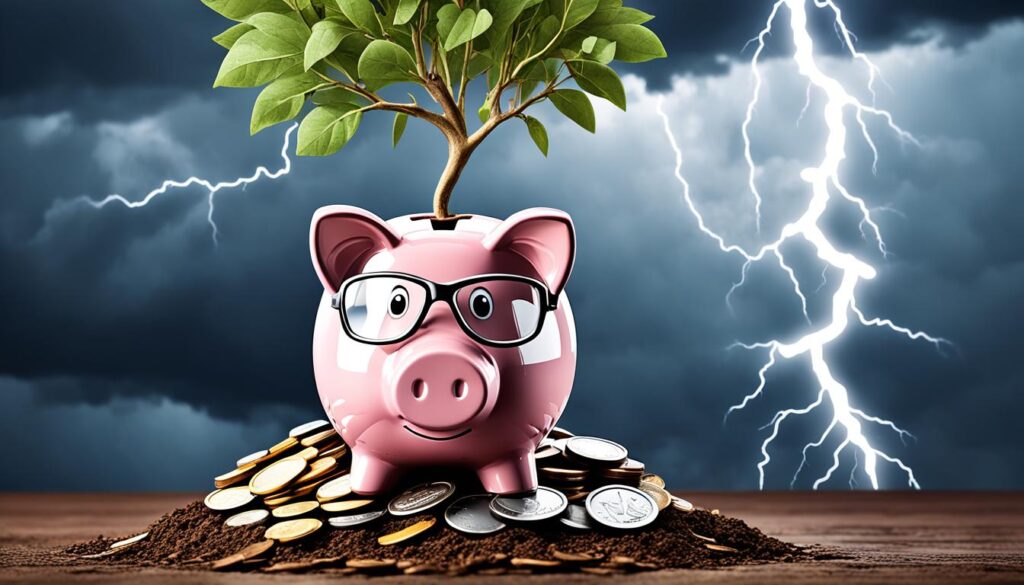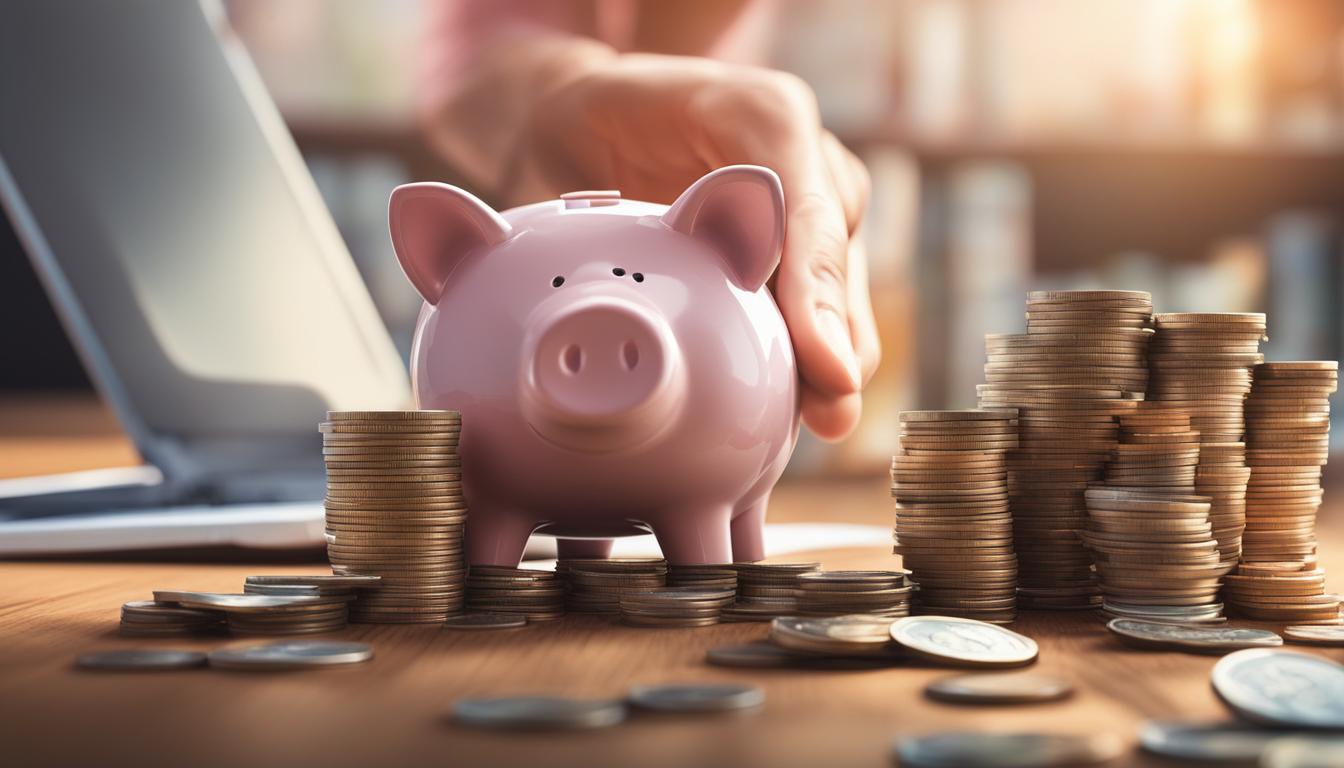Did you know that 40% of Americans would struggle to cover a $400 emergency expense? Living paycheck to paycheck has become a reality for many, leaving little room for unexpected financial burdens. This is where building an emergency fund comes in.
An emergency fund is a crucial component of financial preparedness. It serves as a safety net, providing you with the necessary funds to navigate unexpected expenses or emergencies without derailing your financial stability. Whether it’s a medical bill, car repair, or unexpected job loss, having an emergency fund can make all the difference in maintaining your financial well-being.
Key Takeaways:
- An emergency fund is a cash reserve set aside for unplanned expenses or financial emergencies.
- Research shows that individuals with less savings are more likely to rely on credit cards or loans, leading to debt.
- Building an emergency fund is essential for financial security and preparedness.
- Strategies for building an emergency fund include creating a savings habit, managing cash flow, and making savings automatic.
- An emergency fund should be kept in a safe and accessible place, such as a bank or credit union account.
The Importance of an Emergency Fund
An emergency fund is essential for financial security and preparedness. It serves as a safety net against unexpected expenses, providing peace of mind and protecting you from financial hardships. Without savings, a single unforeseen event can lead to debt and have lasting impacts on your overall financial well-being.
By creating an emergency fund, you can navigate financial emergencies without significant disruption to your life. This fund acts as a rainy day fund, allowing you to address unexpected expenses without relying on credit cards or loans. By doing so, you avoid accumulating unnecessary debt and maintain your financial stability. Additionally, having an emergency fund helps prevent the need to tap into other savings, such as retirement funds, which are meant for long-term goals.
Financial security is crucial in achieving your life goals and enjoying your best life. Having an emergency fund provides the freedom and flexibility to handle unforeseen circumstances without compromising your financial well-being. Whether it’s a medical emergency, a car repair, or a sudden job loss, knowing that you have a financial cushion allows you to navigate these challenges with confidence.
Quotes:
“An emergency fund is like a parachute that ensures a soft landing during financial turbulence.”
“A rainy day fund acts as a guardian angel, protecting you from the storm of unexpected expenses.”
The Role of an Emergency Fund
| Financial Security: | Provides a safety net against unexpected expenses |
|---|---|
| Peace of Mind: | Safeguards against financial hardships and reduces stress |
| Avoid Debt: | Prevents reliance on credit cards or loans |
| Preserve Other Savings: | Protects retirement and long-term investment funds |
| Flexibility: | Allows for the pursuit of life goals without financial constraints |
Building an emergency fund is an important step toward achieving financial security. It requires discipline and commitment, but the benefits far outweigh the effort. Start today by setting aside a designated amount each month, and gradually build up your rainy day fund. Having an emergency fund not only provides a sense of financial security but also empowers you to live your best life, knowing you are prepared for whatever comes your way.
Strategies for Building an Emergency Fund
When it comes to building an emergency fund, there are several strategies you can employ to ensure financial preparedness and provide yourself with peace of mind. These strategies are versatile and can be tailored to suit your unique circumstances and financial goals.
- Create a Savings Habit: One effective approach is to develop a consistent savings habit. Set specific savings goals and allocate a portion of your income towards building your emergency fund. By consistently putting money away, even in small amounts, you can gradually grow your fund over time.
- Manage Cash Flow: Keeping a close eye on your income and expenses is crucial to building your emergency fund. Track your cash flow, adjust your spending if necessary, and prioritize allocating more funds towards your savings. This proactive approach will ensure that you have a steady stream of contributions going into your emergency fund.
- Take Advantage of One-Time Opportunities: Seize any one-time opportunities to save money and give your emergency fund a significant boost. Tax refunds, cash gifts, or unexpected windfalls can all provide an excellent opportunity to pad your fund and accelerate your savings progress.
- Make Savings Automatic: Simplify the savings process by automating your contributions. Set up recurring transfers from your checking account to your emergency fund. Alternatively, if your employer offers contributions to a retirement or savings plan, take advantage of this benefit to ensure consistent and automatic savings.
- Save Through Work: Dividing your paychecks between your checking and savings accounts is an effective way to save for emergencies. By directing funds straight into your emergency fund, you can automate your savings and reduce the temptation to use the money for non-essential expenses.
By implementing these strategies and making a commitment to building your emergency fund, you can develop financial discipline, cultivate a savings habit, and establish long-term financial security.

Having a visual representation of your progress can be a powerful motivator. Consider using a savings tracker to monitor your emergency fund’s growth and celebrate each milestone. Remember, building an emergency fund is a journey, and every step you take brings you closer to achieving financial peace of mind.
Tips for Building an Emergency Fund
Building an emergency fund requires discipline and commitment. By following these tips, you can effectively save for unexpected expenses and achieve financial preparedness.
1. Set Smaller Savings Goals
Setting smaller, achievable savings goals initially can make the process more manageable and provide the motivation to keep going. Start with a realistic target that aligns with your financial situation.
2. Begin with Small, Regular Contributions
Starting with small, regular contributions is crucial to avoid overwhelming your cash flow and maintain consistency in saving for emergencies. Even a few dollars each week can add up over time.
3. Automate Savings
Take advantage of automation by setting up direct deposit or recurring transfers from your paycheck to your emergency fund. This ensures that regular contributions are made without relying on manual deposits, making saving seamless and hassle-free.
4. Resist Temptations
When your savings become automatic, it’s important to resist the temptation to increase your monthly spending or open new credit cards. Stay focused on your ultimate savings goal and avoid unnecessary expenses that could hinder your progress.
5. Maintain Balance
While it’s crucial to have an adequate emergency fund, it’s also important to avoid over-saving. Consider allocating excess savings to other investment opportunities that align with your long-term financial goals. Find the right balance between saving for emergencies and pursuing other financial aspirations.
| Tips for Building an Emergency Fund | |
|---|---|
| Set Smaller Savings Goals | Start with realistic targets to stay motivated. |
| Begin with Small, Regular Contributions | Consistency is key – even small amounts add up. |
| Automate Savings | Make saving effortless by setting up automatic transfers. |
| Resist Temptations | Avoid unnecessary expenses that could derail your savings progress. |
| Maintain Balance | Consider allocating excess savings to other investments. |
By applying these tips, you can build a robust emergency fund that provides the financial security and peace of mind needed to navigate unexpected expenses. Start saving for emergencies today and ensure your financial preparedness for the future.

Conclusion
Building an emergency fund is a critical step towards securing your financial future. By making a commitment to save and implementing tailored strategies, you can gradually build a strong emergency fund that provides financial security and peace of mind.
Creating a savings habit is key to your success. By setting realistic goals and starting with small contributions, you can develop the discipline needed for long-term financial stability. Managing your cash flow allows you to allocate funds towards savings, making each dollar count towards building your emergency fund.
Take advantage of opportunities to save, such as tax refunds or cash gifts, to give your emergency fund a boost. Making savings automatic through recurring transfers and utilizing employer-based contributions ensures consistent growth of your savings. Consider saving through work by dividing your paycheck between checking and savings accounts to accelerate your emergency fund’s growth.
An emergency fund safeguards you against financial shocks and allows you to confidently navigate unexpected expenses. Start building your emergency fund today and secure your future financial well-being. With determination and the right strategies, you can achieve the peace of mind and financial security that comes with having a robust emergency fund.
You may also like: Mastering the Art Creating a Budget: Empowering Your Financial Journey and Empowering Tips for Eating Healthy on a Budget.






